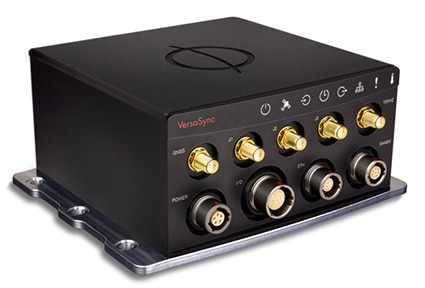# News
New Generation Low SWaP Rugged Time and Frequency Server
ROCHESTER, NY USA (October 4, 2016) — Spectracom has recently introduced a new generation, low SWaP, rugged time and frequency server, called VersaSync. Designed specifically for flight test, telemetry, C4ISRA military system that encompasses the technology and equipment to collect data and communicate with other parts of the system. C4ISR is designed to provide situational awareness on the battlefield., and mobile communication systems, the VersaSync is a high performance GNSSGlobal navigation satellite system (GNSS): A general term describing any satellite constellation that provides positioning, navigation, and timing (PNT) services on a global or regional basis. See also master clock and network time server that delivers accurate, software-configurable time and frequency signals in all circumstances, including GNSS-denied environments.
Strategic product manager, Emmanuel Sicsik-Pare said, “This new product is based on a platform-approach to maximize versatility without restricting performance. We maintained, and in some cases improved, our high-performance standards from larger form factors into a rugged and compact design suitable for air, land or sea applications.” Standard VersaSync configurations are designed in accordance to VITA 75 which was developed for easy integration of subsystems in mobile platforms. The overall volume is under 1 liter, the weight is less than 1 kilogram, and its power consumption is approximately 10 watts. The list of design features for harsh environmental conditions include mil-performance circular connectors, a sealed enclosure (IP65), and an efficient heat transfer via the conduction-cooled based plate.
Versatility also applies to VersaSync’s internal time-base, compatibility with external time and frequency reference sources, and time and frequency signal generation. It is available with a choice of a very low-phase noise ovenized crystal oscillator (OCXO) or chip-scale atomic clocks (CSAC), and can accommodate other high precision internal time references. Similarly it is available with various global navigation satellite receivers including multi-constellation GNSS receivers and SAASM encrypted GPSGlobal Positioning System is a navigation satellite system. See also with an upgrade path to M-Code. Additional references can be added as a back-up to, or in lieu of, navigation satellite signals.
In addition to precision frequency outputs, software-defined digital timing I/Os offer mission-to-mission configurability of virtually any timing signal. Network synchronization and management also offers a high degree of flexibility. Two gigabit Ethernet interfaces are available for network synchronization protocols (NTPNTP, or Network Time Protocol, is a widely used networking protocol that enables computers and devices to synchronize their system clocks with a reference time source. It ensures accurate timekeeping in computer networks by allowing devices to obtain precise time information from NTP servers, which are typically synchronized to highly accurate atomic clocks. NTP is essential for various applications and services that rely on synchronized time, such as network security, authentication, and data logging. and PTPPrecision Time Protocol is a protocol used to synchronize clocks throughout a computer network. On a LAN network, PTP can enable the clocks on each server to be synchronized within a sub-microsecond range, thus making it suitable for demanding applications that require precise timing and control. PTP is standardized within IEEE-1588v2.) as well as for configuration, status, logging and upgradability.
Sicsik-Pare said, “We understand the most demanding timing applications such as next generation radar and satcom-on-the-move programs often have specific requirements. In addition to our flexible low SWaP timing platform we have developed an efficient process to integrate new features. The benefit to our customers is faster time-to-deploy and total lower cost of ownership.”


